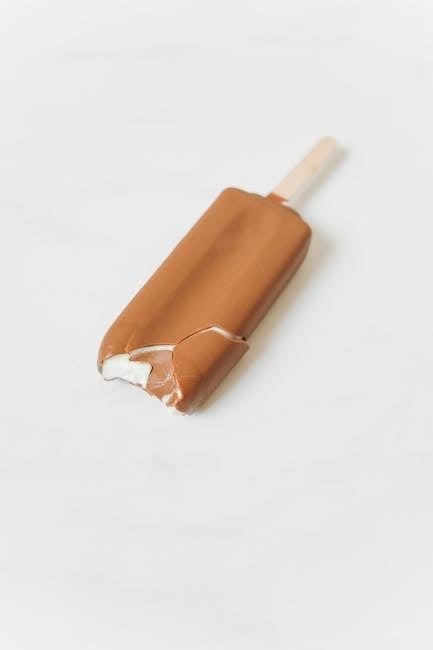A fun and educational DIY project‚ popsicle stick catapults teach physics concepts like potential and kinetic energy through creative design and simple materials.
Overview of the Project
This DIY project involves crafting a simple catapult using popsicle sticks‚ rubber bands‚ and household items. It’s designed for kids and hobbyists to learn basic physics and engineering principles. By following step-by-step instructions‚ participants can assemble the catapult‚ experiment with different projectiles‚ and understand how energy transfer and simple machines work. The project encourages creativity‚ problem-solving‚ and hands-on learning while being fun and educational.
Importance of STEM Learning Through DIY Projects
Engaging in DIY projects like popsicle stick catapults fosters critical thinking‚ creativity‚ and problem-solving skills. These hands-on activities introduce fundamental STEM concepts‚ such as simple machines and energy transfer‚ in an accessible way. By experimenting with designs and observing outcomes‚ participants gain a deeper understanding of physics and engineering principles‚ encouraging curiosity and innovation from a young age.

Materials and Tools Needed
- Popsicle sticks (10-12 sticks)
- Rubber bands (5-6 bands)
- Spoons or small containers for the projectile holder
- Glue (hot glue recommended)
- Scissors for cutting sticks
- String or twine for additional support
Optional: plastic spoon‚ bottle cap‚ or pom-poms for projectiles.
Popsicle Sticks
Popsicle sticks are the primary structural material for the catapult‚ requiring 10 sticks in total. Five full sticks are used for the base and frame‚ while the remaining five are cut in half for additional support. These sticks are essential for creating the rectangular base and assembling the catapult’s framework‚ ensuring stability and durability for launching projectiles effectively.
Rubber Bands
Rubber bands are essential for storing potential energy in the catapult. Typically‚ 5-6 bands are used to create the necessary tension. They are stretched and secured around the frame‚ transferring energy to the launching arm when released. The number of rubber bands can be adjusted to experiment with different launch distances and velocities‚ making them a key component for optimizing performance and exploring physics principles.
Spoons or Small Containers
A spoon or small container serves as the projectile holder in a popsicle stick catapult. Attach it securely to the launching arm using glue or rubber bands; Ensure it’s sturdy enough to hold small items like marshmallows or beads. The shape and size of the spoon can affect the projectile’s trajectory‚ so experiment with different designs for optimal performance and accuracy in your DIY catapult project.
Glue and Scissors
Hot glue is essential for bonding popsicle sticks securely‚ ensuring durability and stability in the catapult’s structure. Scissors are used to precisely cut sticks to the required lengths. Sharp scissors prevent splintering‚ while glue dries quickly to hold the frame together. For safety‚ handle scissors carefully and use glue with adult supervision to avoid accidents. These tools are fundamental for assembling the catapult’s base and frame effectively.
String or Twine
String or twine plays a crucial role in securing the catapult’s components together. Typically requiring 3-4 feet‚ it helps in creating tension and stability. Use it to tie the popsicle sticks firmly‚ ensuring the structure holds. You can also use it to create a trigger mechanism for launching projectiles. Choose durable material to withstand repeated use and maintain consistent performance. Properly securing the string ensures better accuracy and distance in launches.

Step-by-Step Construction Guide
Start by creating a rectangular base with popsicle sticks and glue. Add layers for strength‚ then attach rubber bands for tension. Use string to secure the sling‚ and a spoon as the projectile holder. Test and refine your design for optimal performance.
Building the Base Structure
Start by creating a rectangular base using popsicle sticks. Glue two half sticks to the ends of two full sticks to form a rectangle. Repeat this process‚ adding two more full sticks on top and two half sticks for reinforcement. This sturdy base provides stability for the catapult‚ ensuring a solid foundation for the frame and launching mechanism. Proper alignment and secure gluing are crucial for durability and performance.
Creating the Catapult Frame
Begin by constructing the frame using popsicle sticks and glue. Create a rectangular base by gluing two half sticks to the ends of two full sticks‚ forming a rectangle. Add stability by layering additional sticks on top. Use string or twine to secure the structure‚ ensuring it is sturdy. This frame serves as the foundation for the catapult‚ providing the necessary support for the launching mechanism and projectiles.
Attaching the Launching Arm
To attach the launching arm‚ glue one end of a popsicle stick to the base‚ positioning it at a slight angle. Secure it with rubber bands or string for stability. Ensure the arm is sturdy and can pivot smoothly. This step is crucial for the catapult’s functionality‚ as the arm will store potential energy when pulled back. Proper attachment ensures consistent performance during launches. Test the arm’s flexibility and alignment before proceeding.
Securing the Rubber Bands
To ensure optimal performance‚ stretch rubber bands around the catapult frame‚ looping them securely around the popsicle sticks. Use string or twine to tightly fasten the bands‚ preventing slippage. Wrap them tightly around the frame for maximum tension‚ then tie the ends with a knot. This step is crucial for storing potential energy‚ which will be released when launching projectiles. Properly secured rubber bands enhance the catapult’s range and accuracy.
Adding the Projectile Holder
Attach a small container or spoon to the end of the launching arm using glue or rubber bands. Ensure it is securely fastened to hold projectiles like marshmallows or pom-poms. Proper alignment is crucial for consistent launches. This step allows students to experiment with different projectile types and designs‚ enhancing the learning experience while reinforcing the catapult’s functionality.
Final Assembly and Testing
After assembling all components‚ ensure the structure is stable and secure. Attach the launching arm and projectile holder firmly. Test the catapult by gently pulling the arm back and releasing. Observe the projectile’s flight to assess performance. Adjust the rubber band tension or fulcrum position if needed for better accuracy or distance. This step allows for hands-on learning of Newton’s laws and energy transfer‚ making it an engaging educational experience.

Scientific Principles Behind the Catapult
The catapult demonstrates potential and kinetic energy transfer‚ utilizing leverage and simple machines to propel objects‚ illustrating Newton’s laws of motion in action through its mechanical design.
Understanding Leverage and Simple Machines
The popsicle stick catapult demonstrates the principle of leverage‚ using a fulcrum to amplify force. By bending rubber bands‚ potential energy is stored and released‚ converting to kinetic energy. This simple machine illustrates how effort and load arms work together‚ showcasing basic physics principles in action. The design highlights energy transfer and motion‚ aligning with Newton’s laws of motion.
Potential and Kinetic Energy Transfer
The popsicle stick catapult demonstrates the transformation of energy from potential to kinetic. When the rubber band is pulled back‚ potential energy is stored. Upon release‚ this energy converts into kinetic energy‚ propelling the projectile forward. This process illustrates the fundamental principle of energy conservation‚ providing a hands-on learning experience about energy dynamics.
Newton’s Laws of Motion in Action
The popsicle stick catapult demonstrates Newton’s laws: the stored potential energy in rubber bands (action) converts to kinetic energy upon release (reaction). The projectile’s motion follows inertia and force‚ showcasing how applied forces and resulting accelerations govern its trajectory‚ aligning with Newton’s second law. Air resistance and gravity act as opposing forces‚ while the catapult’s recoil illustrates the third law of equal and opposite reactions.
Troubleshooting Common Issues
Address structural weaknesses by reinforcing joints with glue. Ensure proper rubber band tension for optimal launching power and experiment with projectile weight for consistent results.
Improving Launch Distance
To enhance your catapult’s launch distance‚ experiment with tighter rubber band tension and adjust the launching arm’s angle. Using sturdier materials or adding more rubber bands can increase potential energy‚ resulting in farther throws. Test different projectile weights and shapes to optimize performance. Ensure the fulcrum is securely attached and balanced for maximum efficiency. Small design tweaks can significantly impact distance and accuracy in your popsicle stick catapult.
Fixing Structural Weaknesses
To address structural weaknesses in your popsicle stick catapult‚ ensure joints are securely glued‚ especially at fulcrum points. Reinforce the base by layering additional sticks for stability. Use hot glue for durability and consider adding rubber bands to strengthen connections. If the frame bends under tension‚ add crossbeams or extra sticks for support. A sturdy structure ensures consistent performance and prevents breakage during launching. Regularly inspect and reinforce weak areas to maintain functionality.
Adjusting Tension for Better Performance
Proper tension in the rubber bands is crucial for optimal catapult performance. Tightening the bands increases stored energy‚ while loosening them reduces force. Experiment with different configurations to achieve consistent launches. Ensure the bands are evenly stretched to avoid uneven energy release. Testing various tensions helps determine the ideal balance for distance and accuracy‚ enhancing overall functionality and reliability of your popsicle stick catapult design.

Design Variations and Experiments
Experiment with different projectile types‚ such as marshmallows or pom-poms‚ and test various fulcrum points to explore performance variations and creative design possibilities.
Exploring Different Projectile Types
Experiment with various projectiles like marshmallows‚ pom-poms‚ or small balls to test launch distance and accuracy. Soft materials ensure safety while learning about motion and energy transfer. Try different designs to see how weight affects performance‚ encouraging creative problem-solving and STEM learning. This hands-on approach makes physics fun and accessible for all ages‚ while promoting innovation and critical thinking.
Testing Various Fulcrum Points
Experimenting with different fulcrum positions enhances understanding of mechanical advantage. Moving the fulcrum closer or farther from the launching arm changes the catapult’s performance‚ affecting launch distance and projectile speed. This process helps identify optimal balance between energy transfer and control. By testing multiple configurations‚ users can observe how subtle changes impact overall functionality‚ fostering a deeper appreciation for design and physics principles in action.
Enhancing Durability and Accuracy
Reinforce the catapult’s frame with extra popsicle sticks and hot glue for durability. Use tighter rubber bands to maintain consistent tension‚ improving accuracy. Experiment with different projectile holders‚ such as spoons or bottle caps‚ to find the best fit. Test various designs to optimize performance and ensure reliability. These adjustments enhance both the longevity and precision of your popsicle stick catapult.

Educational Applications
Building popsicle stick catapults introduces students to engineering and design thinking‚ fostering problem-solving skills through hands-on experimentation and exploration of scientific principles.
Teaching Physics Concepts to Students
Building a popsicle stick catapult introduces students to fundamental physics concepts like potential and kinetic energy‚ simple machines‚ and Newton’s laws of motion. By constructing and testing the catapult‚ students observe how stored energy is released and how forces affect motion. This hands-on activity makes complex principles accessible and engaging‚ encouraging curiosity and a deeper understanding of scientific principles through practical application and experimentation.
Encouraging Engineering and Design Thinking
Building a popsicle stick catapult fosters engineering skills by encouraging students to experiment with design variations‚ such as altering fulcrum points or testing different projectiles. This hands-on activity promotes creativity‚ problem-solving‚ and critical thinking‚ allowing learners to see how small changes impact performance. By iterating through designs and analyzing results‚ students develop a deeper understanding of engineering principles and the importance of trial and error in innovation.
Developing Problem-Solving Skills
Building a popsicle stick catapult encourages critical thinking and creativity. Students learn to troubleshoot design flaws‚ experiment with different materials‚ and refine their builds for better performance. This hands-on activity fosters analytical thinking as they test various projectiles and fulcrum points‚ analyzing results to improve accuracy and distance. The iterative process of trial and error helps develop resilience and adaptability‚ essential skills for STEM fields and everyday problem-solving.

Safety Considerations
Always supervise children during construction and use. Handle sharp objects like scissors and glue carefully. Ensure projectiles are launched safely and avoid aiming at people or fragile objects.
Precautions When Using Sharp Objects
When using scissors or craft knives‚ handle them with care to avoid cuts. Always cut away from your body and ensure adult supervision for children. Wear protective gloves if needed‚ and store sharp tools safely out of reach. Keep fingers away from blades and maintain a clean workspace to prevent accidents. Proper safety practices ensure a fun and injury-free building experience.

Ensuring Safe Launching Practices
Ensuring safe launching practices is crucial when using a popsicle stick catapult. Always supervise children during launches and ensure the area is clear of obstacles. Use soft projectiles like marshmallows or pom-poms to avoid damage. Never aim the catapult at people or fragile objects. Teach proper handling to prevent accidental snaps from rubber bands. Conduct regular inspections of the catapult for wear and tear. Follow these guidelines to make the experience enjoyable and hazard-free for everyone involved.
Supervising Children During Construction
Adult supervision is crucial when children assemble popsicle stick catapults‚ especially when using sharp objects like scissors or hot glue guns. Ensure kids handle materials safely and follow instructions carefully. Encourage them to ask questions and seek help when needed. Supervision helps prevent accidents and fosters a learning environment where children can enjoy building while understanding the project’s educational value.
Building a popsicle stick catapult is a fun way to learn about physics. This project teaches fundamental concepts like energy transfer and simple machines‚ inspiring further STEM exploration and creativity.

Constructing a popsicle stick catapult involves assembling a rectangular base‚ layering sticks for stability‚ and attaching a launching arm. Secure rubber bands for tension and add a spoon or container to hold projectiles. Follow step-by-step instructions to ensure structural integrity and proper mechanics. Testing and adjustments are crucial for optimal performance‚ teaching hands-on lessons in physics and engineering principles through creative DIY construction.
Encouraging Further Exploration and Learning
Building a popsicle stick catapult sparks curiosity and creativity‚ inspiring learners to explore physics and engineering. Experimenting with different designs‚ projectiles‚ and fulcrum points encourages problem-solving and innovation. By testing various materials and techniques‚ participants gain hands-on experience with scientific principles‚ fostering a deeper understanding of mechanics and design thinking. This project serves as a gateway to further STEM exploration‚ making learning fun and engaging for all ages.

Additional Resources
Explore further learning with these resources:
- Download step-by-step PDF guides for detailed instructions.
- Find tutorials with clear diagrams and photos.
- Join forums for DIY projects and engineering ideas.
- Share designs and tips with fellow builders.
Recommended PDF Guides and Tutorials
Several PDF guides offer detailed instructions for building popsicle stick catapults‚ including step-by-step diagrams and photos. These resources cover materials like popsicle sticks‚ rubber bands‚ and spoons‚ while explaining scientific concepts. Some guides focus on optimizing launch distance‚ experimenting with projectiles‚ or exploring fulcrum points. They also provide variations for durability and accuracy. Popular PDFs include “Popsicle Stick Catapult: A Step-by-Step Guide” and “Mini Catapult Designs for DIY Enthusiasts.”
Online Communities for DIY Enthusiasts
Online communities like Reddit‚ Instructables‚ and YouTube offer extensive resources and forums for DIY enthusiasts. These platforms provide tutorials‚ step-by-step guides‚ and user experiences for building popsicle stick catapults. Members share tips‚ troubleshoot designs‚ and showcase creative variations. Engaging with these communities fosters collaboration‚ innovation‚ and learning among DIY enthusiasts of all skill levels.
